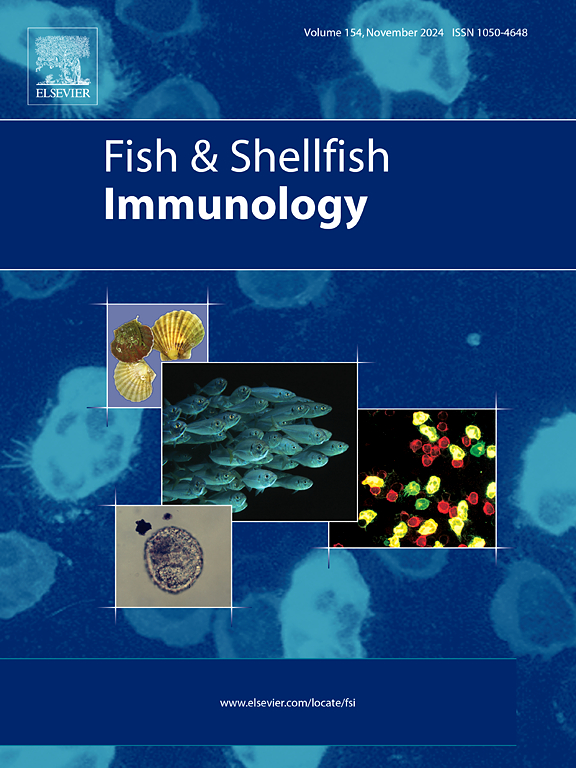Impact of Bambusa vulgaris-supplemented diet on Nile tilapia challenged with Pseudomonas putida: Hematological, immune, and oxidative responses
IF 4.1
2区 农林科学
Q1 FISHERIES
引用次数: 0
Abstract
This study investigated the effects of bamboo shoot extract (Bambusa vulgaris) as a feed additive on the health profiles and infection resistance of Nile tilapia (Oreochromis niloticus) against Pseudomonas putida. Bamboo shoot extract was added at levels of 0 g, 40 g, and 60 g per 1000 g of diet over a 60-day period. The fish were then challenged with a pathogenic P. putida strain. Chemical analysis of the bamboo shoot extract identified 3,5-dinitrophenol and hydroquinone as the two most abundant compounds. Results showed that fish fed bamboo-enriched diets exhibited significantly enhanced levels of red blood cells, hemoglobin, hematocrit, white blood cells, and platelets, and improved erythrocyte cellular and nuclear morphologies, indicating improved health profiles after the challenge. Liver function indicators, including AST, ALT, and ALP, were notably balanced in fish receiving bamboo shoot extract post-challenge (p < 0.05). Blood levels of K+ were lower in the bamboo-fed groups. Additionally, blood levels of Ca++ and Na+ were reduced in fish fed 40 g and 60 g of bamboo, respectively, compared to the control group (p < 0.01). The bamboo extract also enhanced immune and oxidative capacities, as demonstrated by increased catalase, superoxide dismutase, lysozyme activity, and phagocytic activity, along with reduced malondialdehyde levels and elevated serum immunoglobulin M (p < 0.01). Gene expression analysis revealed significant effects of Bambusa vulgaris extract, Pseudomonas infection, and their interaction on the expression of interleukin-1β, interleukin-10, and NK-lysin genes, with varying expression levels at 1, 3, and 7 days post-challenge (p < 0.05). The liver bacterial load in fish exposed to P. putida significantly decreased in the bamboo-fed groups, with the lowest count observed in the 60 g bamboo group. Additionally, survival rates were markedly higher in the bamboo-fed groups compared to the control, with no significant difference between the two bamboo-fed groups. In conclusion, dietary supplementation with bamboo shoot extract enhances hematological parameters, blood cell and nuclear morphology, and increases survival rates in Nile tilapia following infection.
添加竹节饲料对感染恶臭假单胞菌尼罗罗非鱼的影响:血液学、免疫和氧化反应。
本试验研究了竹笋提取物作为饲料添加剂对尼罗罗非鱼(Oreochromis niloticus)健康状况和对恶臭假单孢菌的抗性的影响。在60天的试验期内,每1000 g日粮中分别添加0 g、40 g和60 g竹笋提取物。然后用致病性恶臭假单胞菌菌株攻毒鱼。竹笋提取物的化学分析鉴定出3,5-二硝基苯酚和对苯二酚是两种含量最高的化合物。结果表明,喂食富含竹子的饲料后,鱼的红细胞、血红蛋白、红细胞比压、白细胞和血小板水平显著提高,红细胞和细胞核形态也有所改善,表明鱼的健康状况得到改善。竹笋提取物攻毒后,鱼的肝功能指标AST、ALT和ALP均达到了显著平衡(p < 0.05)。以竹子为食的实验组血液中的钾离子水平较低。此外,饲喂40 g和60 g竹子的鱼血液中Ca++和Na+水平也分别低于对照组(p < 0.01)。竹提取物还能增强免疫和氧化能力,提高过氧化氢酶、超氧化物歧化酶、溶菌酶活性和吞噬活性,降低丙二醛水平,提高血清免疫球蛋白M (p < 0.01)。基因表达分析显示,竹节提取物、假单胞菌感染及其互作对攻毒后1、3、7 d白细胞介素-1β、白细胞介素-10和NK-lysin基因表达有显著影响(p < 0.05)。竹饲组暴露于恶臭假单胞菌的鱼的肝脏细菌负荷显著降低,其中以60 g竹饲组最低。此外,竹食组的存活率明显高于对照组,两组之间无显著差异。由此可见,饲粮中添加竹笋提取物可改善尼罗罗非鱼感染后的血液学指标、血细胞和细胞核形态,提高其存活率。
本文章由计算机程序翻译,如有差异,请以英文原文为准。
求助全文
约1分钟内获得全文
求助全文
来源期刊

Fish & shellfish immunology
农林科学-海洋与淡水生物学
CiteScore
7.50
自引率
19.10%
发文量
750
审稿时长
68 days
期刊介绍:
Fish and Shellfish Immunology rapidly publishes high-quality, peer-refereed contributions in the expanding fields of fish and shellfish immunology. It presents studies on the basic mechanisms of both the specific and non-specific defense systems, the cells, tissues, and humoral factors involved, their dependence on environmental and intrinsic factors, response to pathogens, response to vaccination, and applied studies on the development of specific vaccines for use in the aquaculture industry.
 求助内容:
求助内容: 应助结果提醒方式:
应助结果提醒方式:


